Figure 4
Overview: Figure 4 3D Systems
Applications of Figure 4 3D Printing
Production of fully isotropic parts
Fast creation of prototypes
Short production runs of plastics
Production of transparent, highly heat-tolerant parts
Replacing cast urethane and molding production methods
Developing master patterns and molds for rapid tooling
Creation of fixtures and jigs
Production of end-use plastic parts
Low-volume manufacturing
Materials Used in 3D Printing Designs
Figure 4 PRO-BLK 10
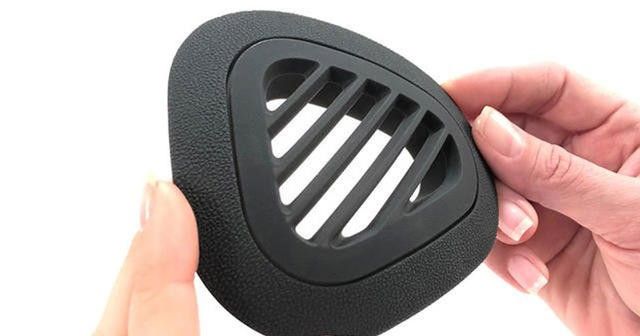 For a quick, easy production experience, our PRO-BLK 10 is the answer. This polypropylene-like material is versatile and heat-resistant, and it is environmentally stable in indoor and outdoor environments.
For a quick, easy production experience, our PRO-BLK 10 is the answer. This polypropylene-like material is versatile and heat-resistant, and it is environmentally stable in indoor and outdoor environments.
PRO-BLK 10 parts can be manufactured quickly — we can produce parts the same day, and our finishing process is quick and straightforward. And even though the production of PRO-BLK 10 is fast, this material is long-lasting and durable.
Applications of PRO-BLK 10
- Ideal for producing small, general-use plastic parts like connectors or interior car parts
- Parts can be assembled and shipped on the same day
- A good replacement option for injection molding manufacturing
Benefits of PRO-BLK 10
- Accurate materials produce a successful print on the first try
- Simplified cleaning and finishing let it ship quickly
- Parts are highly environmentally stable
Key Features
- Print speed is fast at 62 mm/hr for a thickness of 50 microns
- Indoor and outdoor environmental stability is long-term
- Has heat deflection temperature of 70 degrees Celsius and a 12% elongation at break
TOUGH-GRY 10
If you need stable, durable parts and need them quickly, our TOUGH-GRY 10 material is ideal. In some cases, printing speed is even faster than that of PRO-BLK 10. TOUGH-GRY 10 can reach 100 mm per hour. This material produces dark gray pieces that are exceptionally stable, including very humid environments.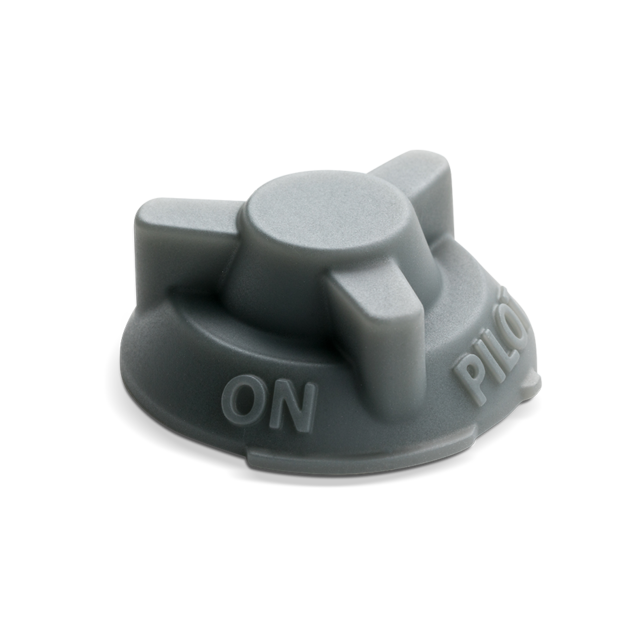
Applications of TOUGH-GRY 10
- TOUGH GRY-10 produces solid parts
- Ideal for snap fits, covers/cases, and parts for automotive styling
- Suitable for parts that need to be painted or otherwise finished upon arrival
Benefits of TOUGH-GRY 10
- Rigid parts remain stable over time
- Dark gray parts can be plated or painted as necessary
- Production speed is rapid
Key Features
- Can reach a print speed of 100 mm per hour
- 25% elongation at break makes it very durable
- Heat deflection temperature at 59 degrees Celsius (at 0.45MPa)
TOUGH-GRY 15
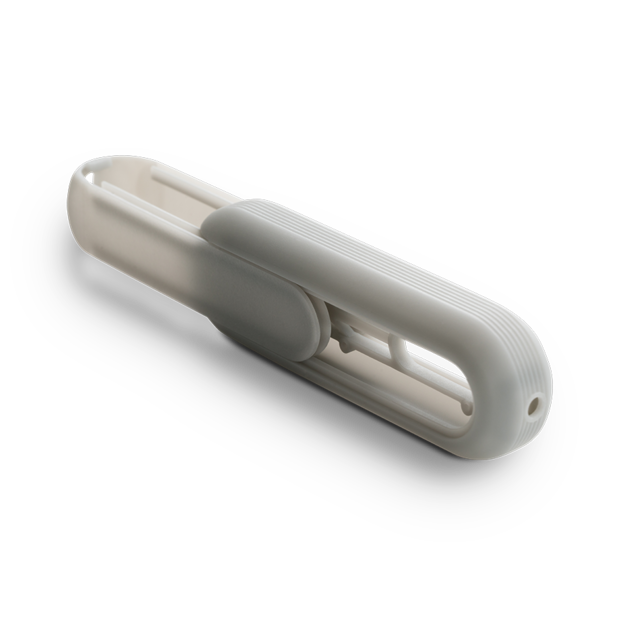 This material is similar to TOUGH-GRY 10, but it has a better elongation at breaking point (33%). TOUGH-GRY 15 is also economically priced and available with a short turnaround time, making it ideal for companies needing fast, affordable production. This material is also a wise choice if you’re creating parts that need to stand up to humid environments, as it is very moisture-resistant.
This material is similar to TOUGH-GRY 10, but it has a better elongation at breaking point (33%). TOUGH-GRY 15 is also economically priced and available with a short turnaround time, making it ideal for companies needing fast, affordable production. This material is also a wise choice if you’re creating parts that need to stand up to humid environments, as it is very moisture-resistant.
Applications of TOUGH-GRY 15
- Ideal for short runs of plastic parts
- High accuracy makes them great for snap fits, cases, and more
- The surface takes well to plating or painting
Benefits of TOUGH-GRY 15
- It is priced very affordably
- Accurate and durable components are very reliable
- Material remains highly stable over time
Key Features
- Heat deflection at 59 degrees Celsius (at 0.45MPa)
- Has 35% elongation at breaking point
- The standard print speed is approximately 41 mm/hr at 0.05 mm.
Figure 4 TOUGH-BLK 20
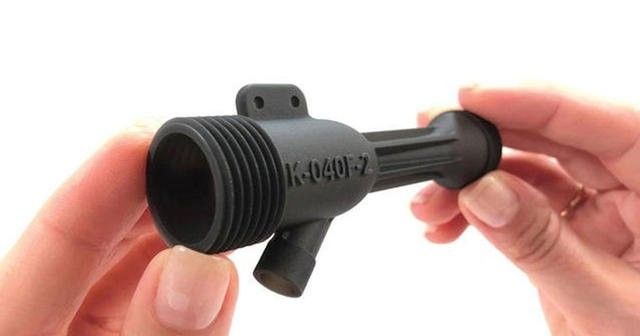 TOUGH-BLK 20 is ideal if you’re looking for a more affordable and efficient way to replace injection-molded ABS plastics. Notably, this material is highly resistant to UV light and will not change color with light exposure. Its excellent environmental stability also means that its mechanical properties will not change over time. TOUGH-BLK 20 also offers a sleeker, smoother surface compared to most other materials.
TOUGH-BLK 20 is ideal if you’re looking for a more affordable and efficient way to replace injection-molded ABS plastics. Notably, this material is highly resistant to UV light and will not change color with light exposure. Its excellent environmental stability also means that its mechanical properties will not change over time. TOUGH-BLK 20 also offers a sleeker, smoother surface compared to most other materials.
Applications of TOUGH-BLK 20
- It produces rigid parts ideal for short-run production
- It’s durable enough to make components of consumer electronics
- Precise, robust quality makes it great for snap-fits
Benefits of TOUGH-BLK 20
- It offers the quality of injection-molded parts without the time or cost
- It’s more environmentally stable than most cheaper materials
- It has exceptionally smooth surfaces
Key Features
- Heat deflection temperature is 55 degrees Celsius (at 0.45MPa)
- Has 36% elongation at break
- The standard print speed is approximately 43 mm/hr with 0.05 mm thickness.
Figure 4 RUBBER-BLK 10
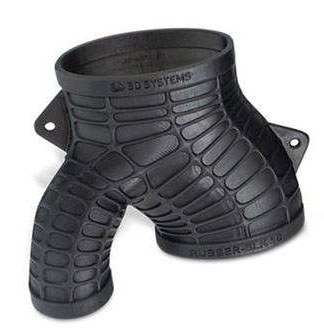 If you need an incredibly durable material with a very high tear strength, RUBBER-BLK 10 is an excellent choice. This material is very similar to hard rubber, and its reliably long-term environmental stability makes it an exceptionally rugged material. RUBBER-BLK 10 is perfect for touch applications like vehicle bumpers, handles, and grips for bicycle handles and other applications. It works incredibly well as a textured surface.
If you need an incredibly durable material with a very high tear strength, RUBBER-BLK 10 is an excellent choice. This material is very similar to hard rubber, and its reliably long-term environmental stability makes it an exceptionally rugged material. RUBBER-BLK 10 is perfect for touch applications like vehicle bumpers, handles, and grips for bicycle handles and other applications. It works incredibly well as a textured surface.
Applications of RUBBER-BLK 10
- Tough enough to be used for couplings
- Suitable for manufacturing any part that requires reliable environmental stability
- Hard, slow-rebound material works well for bumpers, grips, and similar applications.
Benefits of RUBBER-BLK 10
- Smooth, high-quality surface finish ideal for higher-end products
- It is both sturdy and highly tear-resistant
- Suitable for a range of soft-touch coatings
Key Features
- Exceptional 80% elongation at breaking point
- Print speed of 26mm/hr with 0.03 mm thickness
- Tear strength of 76 kN/m
Figure 4 RUBBER-65A BLK
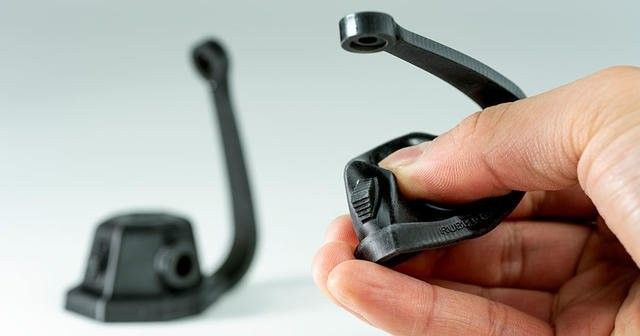 This material is a slow-rebounding, medium-hard rubber-like material. It offers medium tear strength and is a bit more flexible than RUBBER-BLK 10. It works well for vibration dampening and is also suitable for grips, gaskets, and bumpers.
This material is a slow-rebounding, medium-hard rubber-like material. It offers medium tear strength and is a bit more flexible than RUBBER-BLK 10. It works well for vibration dampening and is also suitable for grips, gaskets, and bumpers.
Applications of RUBBER-65A BLK
- Suitable for making gaskets and seals
- Great for making slightly softer grips
- A good choice for pipe spacers
Benefits of RUBBER-65A BLK
- It is a relatively affordable material
- The medium-hard rubber material is very versatile
- It’s effortless to clean
Key Features
- Tear strength of 8.5 kN/m
- The standard production speed is 15 mm/hr at a thickness of 50 micrometers
- Offers 126% elongation at break
Figure 4 FLEX-BLK 20
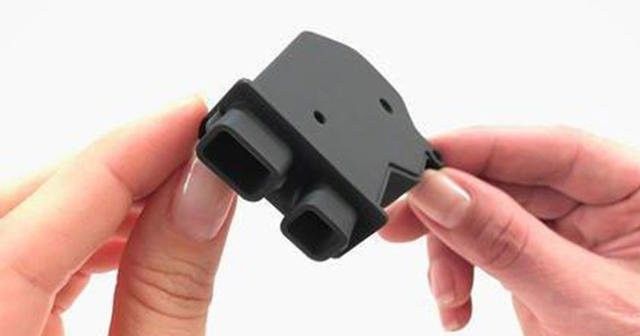 This fatigue-resistant plastic is one of our most durable materials. Its flexibility and high elongation at breaking point make it less likely to become damaged over time, and it’s designed to look and behave like polypropylene. Thanks to its great looks and durability, it’s a very versatile material with plenty of applications.
This fatigue-resistant plastic is one of our most durable materials. Its flexibility and high elongation at breaking point make it less likely to become damaged over time, and it’s designed to look and behave like polypropylene. Thanks to its great looks and durability, it’s a very versatile material with plenty of applications.
Applications of FLEX-BLK 20
- Great for making high-quality cases and enclosures
- A good choice for design prototypes or silicone molding master patterns
- Good for electronics components
Benefits of FLEX-BLK 20
- High-quality parts with very smooth surfaces
- Very robust, fatigue-resistant material
- More environmentally stable than many similar materials
Key Features
- The standard speed of 25 mm/hr at 0.05 mm thickness
- 76% elongation at breaking point
- Heat deflection temperature is 41 degrees Celsius at 0.455 MPa.
Figure 4 HI-TEMP 300-AMB
 Certain plastics will melt or break when used in high-temperature applications, but HI-TEMP 300-AMB can easily withstand the rigors of very high temperatures. And because it’s made of translucent plastic, it’s an ideal choice if you need to evaluate the components behind it. It’s also designed for a quick production, as you don’t need a secondary thermal cure.
Certain plastics will melt or break when used in high-temperature applications, but HI-TEMP 300-AMB can easily withstand the rigors of very high temperatures. And because it’s made of translucent plastic, it’s an ideal choice if you need to evaluate the components behind it. It’s also designed for a quick production, as you don’t need a secondary thermal cure.
Applications of HI-TEMP 300-AMB
- Ideal for use in HVAC, consumer electronics, and other applications involving high heat
- Good for overmolding
- A good choice for low-pressure molding and tooling
Benefits of HI-TEMP 300-AMB
- Rigid, highly heat-resistant material will stand up to high stress
- Translucent plastic is excellent for visualization
- It does not require a secondary thermal post-cure
Key Features
- Has 2.6% elongation at breaking point
- Heat deflection temperature is over 300 degrees Celsius at 0.455 MPa
- The standard production speed is 36 mm/hr at a 50-micrometer thickness
Figure 4 EGGSHELL-AMB 10
 This specialized material is designed to be able to create sacrificial tooling. It’s durable enough to maintain integrity through silicone injection. Once the silicone and mold have cooled, EGGSHELL-AMB 10 is designed to break away easily. It is suitable with most types of silicone, and the translucent material means you can watch the silicone as it’s being injected.
This specialized material is designed to be able to create sacrificial tooling. It’s durable enough to maintain integrity through silicone injection. Once the silicone and mold have cooled, EGGSHELL-AMB 10 is designed to break away easily. It is suitable with most types of silicone, and the translucent material means you can watch the silicone as it’s being injected.
Applications of EGGSHELL-AMB 10
- Great for casting silicone in any durometer
- Can quickly produce quality prototypes
- Ideal for low-volume silicone parts production
Benefits of EGGSHELL-AMB 10
- Translucent material lets you visualize the injection
- It creates excellent details for precise casting
- It can work with most silicone types
Key Features
- Has 5% elongation at breaking point
- Heat deflection temperature is 89 degrees Celsius at 0.455 MPa
- The standard production speed is 43 mm/hr at 0.05 mm thickness
Figure 4 MED-AMB 10
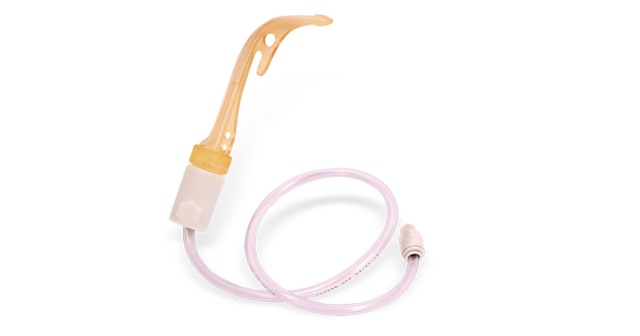
This biocompatible material is designed for use in medical applications as well as industrial ones. It’s perfect for making parts that require very high-definition details, and its high-temperature resistance makes it stable in a wide variety of circumstances. It can be sterilized as needed using an autoclave.
Applications of MED-AMB 10
- Ideal for applications requiring visualization of fluid flow
- Suitable for use in splints and surgical drill guides
- Especially useful in creating threaded assemblies
Benefits of MED-AMB 10
- Can meet biocompatibility standards (ISO 10993-5 and 10993-10)
- Translucent material allows for internal feature evaluation
- Features are delivered in incredible detail
Key Features
- Has 4% elongation at breaking point
- Heat deflection temperature is 119 degrees Celsius at 0.45 MPa
- The standard production speed is 43 mm/hr at a 0.05 mm thickness
Figure 4 FLEX-BLK 10
 FLEX-BLK 10 is ideal if you need parts that are both flexible and durable. This material looks and feels like molded polypropylene, and it’s incredibly durable. Those made with FLEX-BLK 10 are often as durable as those made of cast urethane.
FLEX-BLK 10 is ideal if you need parts that are both flexible and durable. This material looks and feels like molded polypropylene, and it’s incredibly durable. Those made with FLEX-BLK 10 are often as durable as those made of cast urethane.
Applications of FLEX-BLK 10
- Great for functional product design prototypes
- A good choice for silicone molding master patterns
- Great for snap-fit containers and assemblies
Benefits of FLEX-BLK 10
- It is both flexible and impact-resistant, which makes it very durable
- The polypropylene-like finish is smooth and beautiful
- It is ideal for both prototyping and short-run production
Key Features
- Has an impressive 104% elongation at breaking point
- Heat deflection temperature is 52 degrees Celsius at 0.45 MPa
- The standard production time is 33 mm/hr at 0.10 mm thickness
Figure 4 ELAST-BLK 10
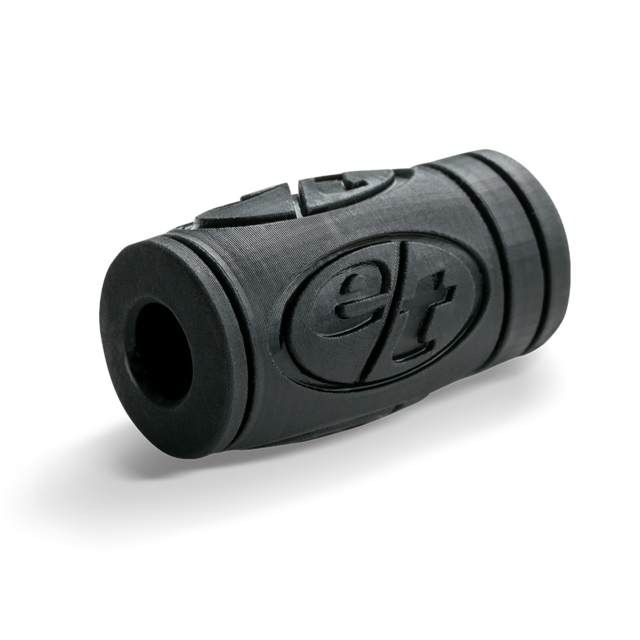 ELAST-BLK 10 is ideal for designing and creating prototypes of elastomeric parts. With medium softness and strength, it’s suitable for a vast array of applications. It regains its shape quickly after compression and looks and feels like natural rubber.
ELAST-BLK 10 is ideal for designing and creating prototypes of elastomeric parts. With medium softness and strength, it’s suitable for a vast array of applications. It regains its shape quickly after compression and looks and feels like natural rubber.
Applications of ELAST-BLK 10
- Great for validating and testing a variety of product designs
- Also good for weatherproofing and other kinds of seals
- Suitable for making hoses and tubes
Benefits of ELAST-BLK 10
- It recovers its shape exceptionally well after compression
- It looks and feels significantly like natural rubber
- Medium softness/stiffness makes it very versatile
Key Features
- The standard production speed is 47 mm/hr at 0.10 mm thickness
- Has 83% elongation at break
- Tear strength of 11 kN/m
Figure 4 Rigid White
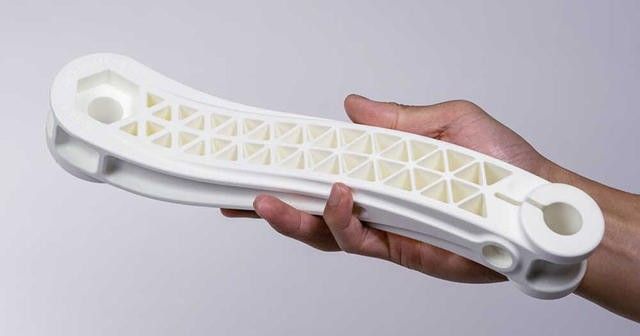 This opaque white material is ideal for both medical and consumer-goods manufacturing. It is durable and has eight years of indoor environmental stability and two years of outdoor. Rigid White is a perfect material for fast production — it doesn’t need a secondary thermal cure, and finished products are highly repeatable.
This opaque white material is ideal for both medical and consumer-goods manufacturing. It is durable and has eight years of indoor environmental stability and two years of outdoor. Rigid White is a perfect material for fast production — it doesn’t need a secondary thermal cure, and finished products are highly repeatable.
Applications of Rigid White
- Great for fixtures on medical devices
- Suitable for smaller components on a variety of products
- Great for guards, covers, and snap-fit parts
Benefits of Rigid White
- Excellent indoor and outdoor environmental stability
- The opaque white color is beautiful and doesn’t fade.
- Short turnaround time for delivering the finished product
Key Features
- Has 20% elongation at breaking point
- Heat deflection temperature is 65 degrees Celsius
- The standard print speed is 47 mm/hr with a thickness of 50 microns
Figure 4 Printer Available Finishes
Natural Finish
- Our quickest, most straightforward finish option — the natural finish simply involves removing the supports from printed materials, washing them, and post-curing before they are shipped.
Paint Ready Finish
- This one is our most thorough finish option. You get all the benefits of a standard finish, but build and layer lines are sanded off using 320 grit sandpaper for a polished, professional look. Following sandblasting, pieces are sanded again using 600 grit sandpaper.
Standard Finish
- For a smoother, more market-ready finish, the standard finish is the way to go. This finish involves support removal, washing, and post-curing, but it also sands where supports were attached using 320 grit sandpaper. For an extra-smooth appearance, pieces are then sandblasted using 320 grit aluminum oxide sand.
Benefits of Using 3D Printing Solutions
But with the Figure 4 technology, the triple constraint is turned on its head — you get a good, low cost product quickly.
Good
Figure 4 technology creates very high-quality parts, and those results are repeatable. A test of 30 samples from Figure 4 machines discovered a process capacity index greater than two — a product that is considered six-sigma quality. It means that Figure 4 is now the industry leader in terms of accuracy.
Additionally, Figure 4 offers a wide range of some of the best materials for any application. Whether you need tear-resistant rubber, fast-printing plastic, or transparent heat-resistant parts, we likely have something for you.
Low Cost
Figure 4 technology also saves considerable money during the manufacturing process. During comparative testing of Figure 4 technology versus urethane casting, the cost per part (in this case, a dashboard vent) using Figure 4 was $7.90. The price per part with urethane casting was $35.10.
Another test found that Figure 4 manufacturing also saved money over injection molding. The estimated combined cost of CAD, tooling design, and tooling labor (for eight days) using injection molding was $4,315. For Figure 4 technology, the price was $121.
Fast
Our Figure 4 machines are among the fastest in the industry. Depending on the material used, they can print at speeds up to 100mm/hr. And they save time over the long term, too. In the above comparison with urethane casting, the first part with Figure 4 was 1.5 hours. For urethane casting, it was 156 hours. Similarly, compared with injection molding, the first part with Figure 4 was 92 minutes. With injection molding, it was 15 days.
Biocompatibility Statement for Figure 4 Materials
A number of our Figure 4 Materials are ISO 10993-5 and ISO 10993-10 capable.
Test coupons printed and processed according to the post processing instructions provide in each material specification sheet were provided to an external biological testing laboratory for evaluation in accordance with ISO 10993-5, Biological evaluation of medical devices – Part 5: Tests for in vitro cytotoxicity, and ISO 10993-10, Biological evaluation of medical devices – Part 10: Tests for irritation and skin sensitization (GPMT). The test results indicate that Figure 4 materials have passed the requirements for biocompatibility according to the above tests.
Disclaimer: It is the responsibility of each customer to determine that its use of Figure 4 materials is safe, lawful and technically suitable to the customer’s intended applications.
Customers should conduct their own testing to ensure that this is the case. Because of possible changes in the law and in regulations, as well as possible changes in these materials, ATAG Incorporated, LLC cannot guarantee that the status of these materials will remain unchanged or that it will qualify as biocompatible in any particular use. Therefore, ATAG Incorporated, LLC recommends that customers continuing to use these materials verify their status on a periodic basis.
Get Started
